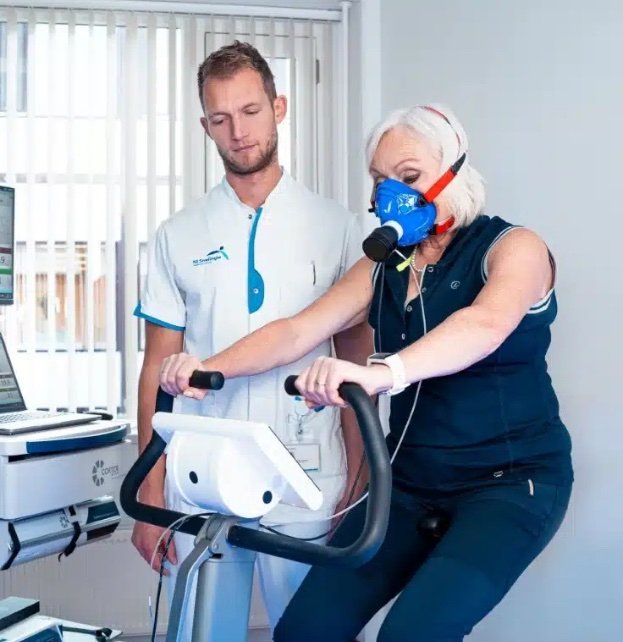
Cardiopulmonary sub-max and maximal VO2 Fitness Testing
CPET is a non-invasive tool for assessing the overall functionality of both cardiac and pulmonary systems. Even sub-maximal CPET for health has mortality predictiveness and can be used for pre- and post-operative assessments in combination with a cardiac clinic.
VO₂ / CFR strongly predicts mortality & test-based fat / carbohydrate zone setting (FAT-max & thresholds)
-
Sub-max cycle test (no maximal effort needed) to estimate VO₂ and prescribe HR zones safely; great for cardiac/metabolic rehab and return-to-activity.
Max- cycle testing only for athletes to measure VO₂ and prescribe HR zones to burn fat or carbohydrates.
-
Resting checks (ECG/HR/BP as indicated) → ramped sub-max protocol → recovery; nasal cannula/light mask (or device standard) + HR monitor.
Prep: avoid heavy exercise 24 h; usual meds unless advised; shoes; light snack ≥2 h prior.
Aged over 65 requires GP clearance to carry-out testing.
An exceptional non-invasive tool for assessing the overall functionality of both cardiac and pulmonary systems.
Our CPET typically involves cycling on an ergometer for 3 stages using sub maximal protocols . The intensity of exercise is mild to moderate and incrementally increased to assess how the body responds.
Typical Test Protocols It's particularly valuable in diagnosing and managing conditions like chronic obstructive pulmonary disease (COPD), coronary artery disease, chronic heart failure, pulmonary hypertension, and interstitial lung disease.
Risk stratification: We know in general CPET can help in risk stratification, aiding in predicting outcomes and planning treatments.
Utility in clinical practice: CPET is a valuable tool in clinical practice for assessing patients with uncovering cardiopulmonary conditions and suggesting specialist help along with tailoring exercise prescriptions.
-
Who benefits:
Older adults (falls risk, frailty, muscle preservation)
Cardio-metabolic risk (obesity, T2DM, dyslipidaemia)
Return-to-activity / post-event rehab (objective baselines)
Considerations/contraindications: Pacemaker/ICD (clinic policy), pregnancy, oedema shifts — interpret trends with context.
Algorithms based on the individuals true hydration state so fat mass and fat free mass estimates are more accurate.
Predictive formulas and specific reference values for paediatric, adult and geriatric populations are applied spearately.
-
Safe sub-max test (no all-out effort) to set HR zones and quantify fitness (VO₂).
Turns numbers into a clear programme you can follow.
Shows progress at 6–8 weeks.
VO₂ and efficiency results aren’t just ‘fitness numbers’—they’re linked to long-term health and survival. Even small improvements matter, and we turn your test into clear HR/BP zones so you can train safely toward better outcomes.”
-
VO₂ estimate, ventilatory response, HR zones (e.g., Z1–Z3/Z5), RPE targets; BP/HR ceilings if vascular limits apply.
Translation: FITT plan (frequency, intensity, time, type) with weekly minutes.
Delivery: Programme/clinician PDF in 2–3 business days (priority 24 h); CSV of key metrics on request.
-
in the famous Hambrecht et al.(1993) study - patients with stable coronary artery disease willing to devote their leisure time partly to “prescribed” physical exercise were rewarded with an upward shift of their anaerobic threshold during sub-maximal exercise . To achieve this goal, it was determined a minimum of 1,400 kcal/week must be expended. Exercise performed at lower intensity levels, most rehabilitation programs, failed to change the position of patient anaerobic threshold. - This is likely because they go unmonitored and safe levels of exercise and progress go unmonitored.
Thus the data gathered from CPET can be used to guide treatment decisions, monitor disease progression, for cardiac and respiratory conditions and evaluate the effectiveness of interventions.
-
Rehabilitation is a familiar term used in medical settings to describe the process of helping individuals recover. Recovery from physical, mental, or cognitive abilities after an injury, illness, or surgery and may involve physical therapy to restore movement and mobility. Scientific research also shows that a physically fit patient demonstrates increased resilience during critical events such as surgery or illness.
Proper exercise prescription is essential for physical fitness, especially for vulnerable patients who need guidance, as such pre-rehabilitation can occur before a significant medical event such as surgery to increase successful outcomes.
Did you know about: Pre-operative CPET Assessment
For patients scheduled for high-risk surgeries, CPET particularly sub-maximal can be used to evaluate stroke and other complication risks. It also helps predict post-operative risks and complications, thus aiding in surgical planning and patient counselling.

